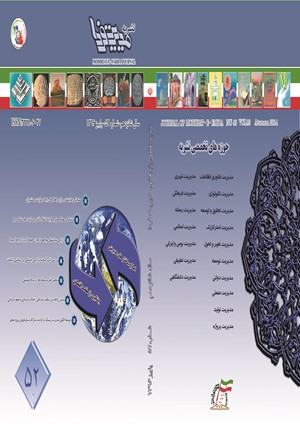مطالعه رفتار سوختگیری و تمایلات رانندگان به منظور طراحی زیرساخت جایگاه های سوختگیری هیدروژن (مطالعه موردی: شهر مشهد)
محورهای موضوعی : مدیریت شهریاحسان لطفی 1 , رضا شیخ 2 , بزرگمهر اشرفی 3
1 - مهندسی صنایع و مدیریت
2 - دانشگاه صنعتی شاهرود
3 - دانشگاه صنعتی شاهرود
کلید واژه: خودروهای با سوخت جایگزین, بهینه سازی, توسعه زیرساخت, ایستگاه های سوختگیری هیدروژن, ترجیحات سوختگیری رانندگان ,
چکیده مقاله :
هدف از این مقاله ارائه یک مدل بهینه سازی برای برنامه ریزی راهبردی مختص ایستگاه های سوختگیری هیدروژن در یک شهر (شهر مشهد) در شرایط در دست نداشتن داده های مبدأ و مقصد (OD) است. مدل ما این مدل دو شرط را در نظر می گیرد: حداکثر کردن ترافیک (مسیرهای رفت و آمد) تحت پوشش ایستگاه های سوختگیری منتخب و به حداقل رساندن متوسط فاصله ساکنان تا نزدیکترین ایستگاه سوختگیری هیدروژن. چون فرض می شود که داده های OD را در اختیار نداریم، از تجمع ایستگاه ها در مناطق دارای بالاترین ترافیک شهر با قید جدیدی ممانعت به عمل می آید که اطلاعات توزیع ایستگاه های سوختگیری فعلی را مد نظر قرار می دهد. این مدل برای شهر مشهد با مساحتی در حدود 3 هزار کیلومترمربع و جمعیت 3 میلیون نفری به کار گرفته شد. در این کار از نتایج نظرسنجی از بیش از 200 راننده مشهدی (غیر تاکسیران) در مورد ترجیحات سوختگیری فعلی شان، تمایلشان به استفاده از وسایل نقلیه با سوخت هیدروژن و حداقل نیازشان (با توجه به حداکثر فاصله تا پمپ و تعداد ایستگاه های موجود در شهر) برای ایجاد شبکه ای از ایستگاه های سوختگیری جایگزین استفاده شده است.
The aim of this paper is to present an optimization model in order to make a strategic plan to develop hydrogen refueling stations in a city when Origin–Destination (OD) data are not available. This model assumes two objectives: maximizing the traffic covered by the selected hydrogen refueling stations and minimizing the average distance of the city’s inhabitants to the nearest hydrogen refueling station. As OD data are considered to be unavailable, positioning the stations in the highest traffic zones is avoided by a new constraint that takes into account information on the distribution of existing conventional refueling stations. This model is applied to Mashhad of about 3 thousand square with a population of around 3 million. This application had used the results of a survey on more than 200 drivers on their current refueling preferences, their willingness to use alternative fuel vehicles and their minimum requirements (regarding maximum distance to be traveled to refuel and number of stations in the city) when establishing a network of alternative refueling stations
پورتال مرکز مدیریت ترافیک شهر مشهد: https://traffic.mashhad.ir #
Achtnicht, M., Bühler, G., Hermeling, C., 2012. The impact of fuel availability on demand for alternative-fuel vehicles. Transport. Res. Part D 17 (3), 262–269#.
Brey, J.J., Contreras, I., Carazo, A.F., Brey, R., Hernández-Díaz, A.G., Castro, A., 2007. Evaluation of automobiles with alternative fuels utilizing multicriteria techniques. J. Power Sources 69, 213–219#.
Bunzeck, I., Backhaus, J., Hoevenaars, B., 2010. Building a hydrogen refuelling infrastructure in the Netherlands: influencing factors from the car drivers’ perspective. In: 18th World Hydrogen Energy Conference.#
European Commission, 2011. Road map to a single European transport area – towards a competitive and resource efficient transport system. White Paper, European Commission, Brussels#.
Goodchild, M., Noronha, V., 1987. Location–allocation and impulsive shopping in the case of gasoline retailing. In: Ghosh, A., Rushton, G. (Eds.), Spatial Analysis and Location-Allocation Models. van Nostrand Reinhold, New York, pp. 121–136.#
Hodgson, M.J., 1990. A flow capturing location–allocation model. Geograph. Anal. 22, 270–279.#
Hodgson, M.J., Rosing, K.E., 1992. A network location-allocation model trading off flow capturing and p-median objectives. Ann. Oper. Res. 40, 247–260.#
Kelley, S., Kuby, M., 2013. On the way or around the corner? Observed refueling choices of alternative-fuel drivers in Southern California. J. Transport Geogr. 33, 258–267#.
Kitamura, R., Sperling, D., 1987. Refueling behavior of automobile drivers. Transport. Res. Part A 21 (3), 235–245#
Lin, Z., Ogden, J., Fan, Y., Chen, C., 2008. The fuel-travel-back approach to hydrogen station siting. Int. J. Hydrogen Energy 33, 3096–3101.#
Nicholas, M., 2010. Driving demand: what can gasoline refueling patterns tell us about planning an alternative fuel network? J. Transport Geogr. 18, 738– 749.#
Nicholas, M.A., Handy, S.L., Sperling, D., 2004. Using geographic information systems to evaluate siting and networks of hydrogen stations. Transport. Res. Rec. 1880, 126–134.#
Riemann, R., Wangb, D.Z.W., Busch, F., 2015. Optimal location of wireless charging facilities for electric vehicles: flow-capturing location model with stochastic user equilibrium. Transport. Res. Part C 58, 1–12.#
Sperling, D., Kitamura, R., 1986. Refueling and new fuels: an exploratory analysis. Transport. Res. Part A 20 (1), 15–23.#
Toyota, 2014. http://toyota.com/fuelcell/fcv.html (November 2014)#


